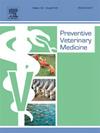东南亚、中国和蒙古摆脱亚洲1型口蹄疫病毒的可能性
IF 2.4
2区 农林科学
Q1 VETERINARY SCIENCES
引用次数: 0
摘要
2018年至2024年期间,东南亚、中国和蒙古未报告亚洲1型口蹄疫病毒(FMDV)血清型,尽管该地区流行口蹄疫,南亚继续流行亚洲1型血清型。虽然该地区仍偶尔使用针对亚洲1型的疫苗,但尚不清楚缺乏报告是否表明真正的疾病自由或监测空白。本研究旨在利用情景树方法估计现有被动监测系统的敏感性,以及在8个国家中亚洲1型血清型区域自由的可能性。建立了两种随机情景树模型来评估口蹄疫(任何血清型)和亚洲1型血清型的监测敏感性。具体国家的输入参数来自对国内专家关于口蹄疫疫苗接种做法、小农行为、抽样方案和诊断实验室能力的问卷调查。此外,2010 - 2022年提交的口蹄疫临床样本和亚洲1号确诊病例的数据来自世界口蹄疫参考实验室。在设计的村一级年发病率为10 %,动物一级年发病率为20 %的情况下,估计口蹄疫监测灵敏度范围从蒙古的100.0% %和中国的95.9% %到柬埔寨的1.7 %和缅甸的 0.1 %。利用有效设计发生率(村庄水平的中位数为0.02 - 0.07 %,动物水平的中位数为20 %),估计每个国家发现亚洲1型的概率为0.0 - 6.7 %,该地区为14.5 %。在没有报告的第一年后,亚洲1地区自由的估计概率为53.9% %。在没有报告的年份,只有当年引入风险保持在6% %以下时,这种可能性才会增加。结果对采样强度和小农行为相关的参数最为敏感,特别是在监测灵敏度高的国家,如蒙古和中国。我们的研究结果强调了该地区被动监测的低灵敏度,表明在目前的监测工作下,亚洲1型血清型可能仍未被发现。加强数据收集和继续努力提高监测强度对于提高对区域免受亚洲1型血清型感染的信心至关重要。本文章由计算机程序翻译,如有差异,请以英文原文为准。
Probability of freedom from foot-and-mouth disease virus serotype Asia 1 in Southeast Asia, China and Mongolia
Foot-and-mouth disease virus (FMDV) serotype Asia 1 has not been reported in Southeast Asia, China and Mongolia between 2018 and 2024, despite the endemicity of FMD in this region and the continued circulation of serotype Asia 1 in South Asia. While vaccines against Asia 1 are still occasionally used in this region, it is unknown whether the absence of reports indicates true disease freedom or surveillance gaps. This study aimed to estimate the sensitivity of existing passive surveillance systems, and the probability of regional freedom from serotype Asia 1 across eight countries using the scenario tree approach. Two stochastic scenario tree models were developed to estimate surveillance sensitivity for FMD (any serotypes) and serotype Asia 1 specifically. Country-specific input parameters were derived from a questionnaire survey of in-country experts on FMD vaccination practices, smallholders’ behaviour, sampling protocols and diagnostic laboratory capacity. Additionally, 2010 – 2022 data on FMD clinical samples submitted and confirmed Asia 1 cases were obtained from the World Reference Laboratory for FMD. Under a design annual incidence rate of 10 % at the village level and 20 % at the animal level, estimated surveillance sensitivity for FMD ranged from 100.0 % in Mongolia and 95.9 % in China to 1.7 % in Cambodia and < 0.1 % in Myanmar. Using the effective design incidence rate with a median of 0.02 – 0.07 % at the village level and 20 % at the animal level, the probability of detecting Asia 1 was estimated to be 0.0 – 6.7 % per country and 14.5 % for the region. The estimated probability of regional freedom from Asia 1 was 53.9 % after the first year without reporting. Over years of no reporting, this probability would increase, only if an annual risk of introduction remained below 6 %. The results were most sensitive to parameters related to sampling intensity and smallholders’ behaviour, particularly in countries with high surveillance sensitivity, such as Mongolia and China. Our findings highlight the low sensitivity of passive surveillance in the region, suggesting that serotype Asia 1 may have remained undetected under the current surveillance efforts. Strengthening data collection and continued efforts in increasing surveillance intensity are essential to improving confidence in the regional freedom from serotype Asia 1.
求助全文
通过发布文献求助,成功后即可免费获取论文全文。
去求助
来源期刊

Preventive veterinary medicine
农林科学-兽医学
CiteScore
5.60
自引率
7.70%
发文量
184
审稿时长
3 months
期刊介绍:
Preventive Veterinary Medicine is one of the leading international resources for scientific reports on animal health programs and preventive veterinary medicine. The journal follows the guidelines for standardizing and strengthening the reporting of biomedical research which are available from the CONSORT, MOOSE, PRISMA, REFLECT, STARD, and STROBE statements. The journal focuses on:
Epidemiology of health events relevant to domestic and wild animals;
Economic impacts of epidemic and endemic animal and zoonotic diseases;
Latest methods and approaches in veterinary epidemiology;
Disease and infection control or eradication measures;
The "One Health" concept and the relationships between veterinary medicine, human health, animal-production systems, and the environment;
Development of new techniques in surveillance systems and diagnosis;
Evaluation and control of diseases in animal populations.
 求助内容:
求助内容: 应助结果提醒方式:
应助结果提醒方式:


